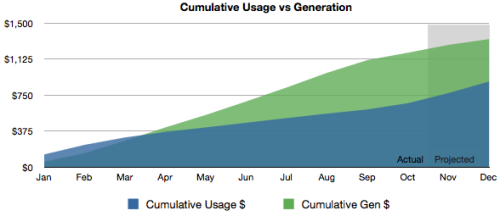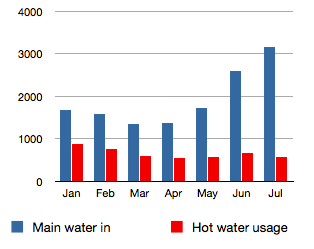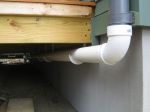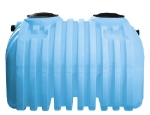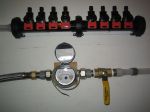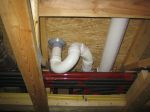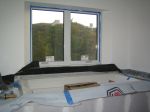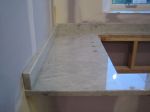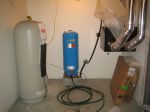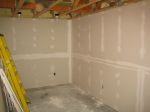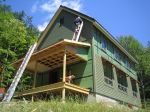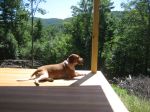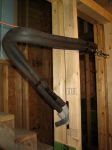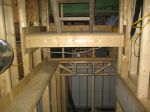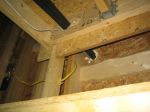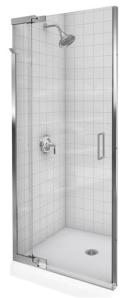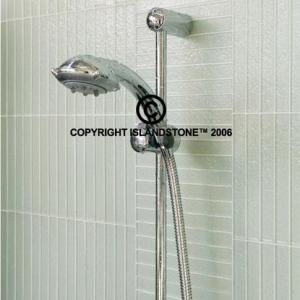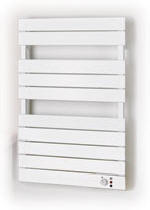October was overshadowed by the events of the last week. Despite the best efforts of Hurricane Sandy we are safe and dry at Up Hill House. We had plenty of strong wind gusts, but not nearly as bad as the costal regions. We were prepared for the worst. We stocked up on water and easy to prepare meals. We have a small propane burner that can be used to heat water or simple cooking. We packed the chest freezer with ice. We filled the bathtub for flushing and the cistern was full for the farm critters. Thankfully the power never went out.
October was considerably more cloudy. We only generated 511 kWh, down 73% from September, but still about 43 kWh better than predicted.
We used 433 kWh, our highest month since March. That’s up 48% from the previous month. We turned on the heating for a 27 hour stretch starting on October 3rd at 3pm, although I can’t remember why. It wasn’t particularly cold inside or out. We used a total of 6.3 kWh for those 27 hours. That only accounts for 1.5% of our month’s total usage. The big increase was due to washing dishes, cloths and cooking (256 kWh versus 164 kWh the previous month). I like to refer to this as the mother-in-law effect. Unfortunately we were not able to use the clothes line this month due to lady bug beetle swarms.
Despite the lower solar generation and the higher usage, we still managed to squeak out a 78 kWh surplus this month, our 8th surplus month in a row, and likely our last for the year. We’re still on track to produce more than we use in our first year.
The number of hours we experienced temperature values below 68F increased to 446 HDD, slightly milder than average for October in our area. Our water usage increased this month, due to extra wash loads and additional water we stored in case we lost power during Sandy. We averaged 65.6 gallons per day.
| Month | Solar PV | Usage | Net usage or (surplus) | Avg. daily usage | HDD3,4 |
| Jan1 | 369 | 873 | 504 | 28.2 | 1,2125 |
| Feb2 | 597 | 666 | 69 | 23.0 | 1,045 |
| Mar6 | 860 | 515 | (345) | 16.6 | 704 |
| Apr7 | 925 | 378 | (538) | 12.9 | 617 |
| May | 867 | 309 | (558) | 10.0 | 298 |
| Jun | 939 | 325 | (614) | 10.8 | 144 |
| Jul | 970 | 319 | (651) | 10.3 | 34 |
| Aug | 1,018 | 315 | (703) | 10.2 | 56 |
| Sep | 883 | 292 | (591) | 9.7 | 188 |
| Oct | 511 | 433 | (78) | 14.0 | 446 |
1 January values based on meter reads.
2 February values based on TED data.
3 Heating Degree Days, a measure of how many outside degrees in a day it is below a base target inside temperature, 68F.
4 Calculated from our HOBO outdoor weather monitor hourly data, unless otherwise noted.
5 January HDD data downloaded from degreedays.net, Station ID: KALB (Albany International Airport).
6 March values based on meter reads. (TED died March 1st, eMonitor installed March 16, 2012)
7 Values starting in April are based on eMonitor data.
I put this chart together for the Green Building Open House Tour. I wanted to show in dollars, how much power we’ve used and how much we’ve generated since we moved in at the beginning of the year. As of the end of October, we’ve used 4,434 kWh and generated 7,939 kWh. At roughly $0.15 per kWh that works out to $665 in electricity usage versus $1,191 for electricity produced. Of course we don’t get 15 cents a kWh when we sell it back to the grid, but it illustrates that we’re accumulating value faster than we’re spending it over the year.
You can see heat maps and detailed charts of temperature and electrical usage at netplusdesign.com. View solar, usage, net usage, temperatures and HDD for all of February and circuit-level data for 16 days in March and the full months of April through October.

